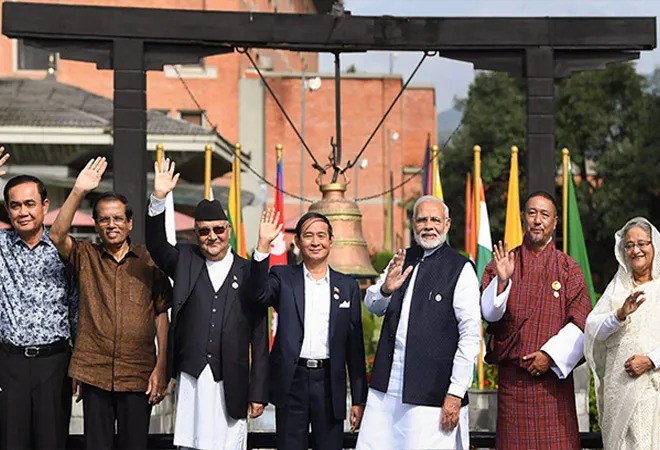The fourth BIMSTEC Summit in Kathmandu on 30 and 31 of August is a positive step towards a Bay of Bengal community, an idea long desired but neglected. The actual realisation of the of the idea of one Bay of Bengal community will be lengthy and require continuous nurturing with an active involvement of the countries of the region, and implementation of the promises made in the summit will be crucial.
BIMSTEC, the acronym for the Bay of Bengal Initiative for Multi-sectoral Technical and Economic Cooperation, is an organisation of the countries surrounding the Bay of Bengal.
Often the success of a summit is weighed from the number of deals signed during it, and in the present summit, only a Memorandum of Understanding on BIMSTEC Grid Interconnection was signed, giving reason to doubt the jubilation about the summit. A closer view of the summit suggests more than one reason to be optimistic.
The theme of the Kathmandu summit was — “towards a peaceful, prosperous and sustainable Bay of Bengal.” It was attended by the top leadership of all the member countries indicating their support to the idea.
BIMSTEC has seven member countries including Bangladesh, India, Myanmar, Sri Lanka, Thailand, Nepal, and Bhutan.
Policy reforms suggested to strengthen Secretariat
< style="color: #000000">A substantial portion of the Kathmandu declaration suggested policy reform measures aiming to strengthen the Secretariat, the institution responsible for running the activities of the BIMSTEC. < style="color: #000000">Strengthening Secretariat was considered crucial for the future growth of the organisation.
< style="color: #000000">Besides that, the declaration includes issues like agricultural technology exchange, fight against terrorism, gradual reduction of the impact of climate change, increase of trade and investment and ease of visa for people of BIMSTEC member states.
Strengthening the BIMSTEC Secretariat was considered crucial for the future growth of the organisation.
< style="color: #000000">The document also stresses on the reduction of poverty and the countries committed to the eradication of poverty by 2030 in line with the sustainable developmental goal.
< style="color: #000000">Additionally, the document strongly condemns terrorism in all forms. The Kathmandu declaration also emphasises the importance of connectivity as an important driver for economic integration for shared growth and prosperity, and the prominence of trade and investment for fostering socio-economic development in the region.
BIMSTEC was established in 1997 in Bangkok. It envisioned peace and prosperity in the Bay of Bengal region by enhancing economic cooperation amongst countries in the region.
Originally, it had four members and named BIST-EC (Bangladesh, India, Sri Lanka, and Thailand Economic Cooperation). With Myanmar joining the group in December 1997, the organisation was renamed BIMST-EC.
BIMSTEC attained its present name after Nepal and Bhutan joined the grouping in 2004.
The organisation has 15 priority areas for cooperation, including Trade & Investment, Transport & Communication, Energy, Tourism, Technology, Fisheries, Agriculture, Public Health, Poverty Alleviation, Counter-Terrorism & Transnational Crime, Environment & Disaster Management, People-to-People Contact, Cultural Cooperation, Climate Change and Blue Economy.
Lack of political will hampered growth
< style="color: #000000">In the two decades of its existence, however, BIMSTEC has seen limited achievements. Member countries have often been accused of not showing the requisite political will to push the growth of the organisation. The gap in the frequency of the summits has often been considered a mark of reluctance of the member nations. Prior to the Kathmandu meeting, there have been only three BIMSTEC summits.
< style="color: #000000">The first summit was held in Bangkok, Thailand in 2004, the second in New Delhi, India in 2008 and the third one in Naypyidaw, Myanmar in 2014.
< style="color: #000000">The member countries were also accused of not supporting the BIMSTEC Secretariat with adequate financial and manpower resources constraining the performance of the body. The organisation got a major boost after BIMSTEC leaders met during the BRICS summit in Goa in 2016.
< style="color: #000000">After the meeting, the activities of the organisation have grown manifold.
The delay in the summit was considered a major impediment to the progress since the necessity for reforming the organisation was felt to enhance the activities.
< style="color: #000000">Some of the major achievements include meetings of the national security advisors to discuss traditional and non-traditional security issues and joint disaster management exercises. The delay in the summit was considered a major impediment to the progress since the necessity for reforming the organisation was felt to enhance the activities.
< style="color: #000000">Also, an urge for direction from the top leadership was felt for prioritising the areas of cooperation. The decision on such issues could only be attained at the summit level because it is the highest policy-making body of the organisation.
Need to sustain momentum
The Bay of Bengal region does not only connect the ecologies of Himalayas with that of the Indian Ocean, it is also a major point of the maritime trading route.
Being home to one-fifth of the humanity with a combined GDP of $2.8 trillion, the region has the potential to become a hub of economic activities.
< style="color: #000000">To leverage the opportunities the region offers, a strong regional cooperation mechanism is necessary.
< style="color: #000000">The present summit has shaken up the inertia of the countries, however, to sustain the momentum it will be necessary to conclude the negotiation of all the agreements that are in the pipeline. An early conclusion of the Free Trade Agreement will be most welcome, since it has been long pending.
< style="color: #000000">Also, connectivity projects should be given priority, and agreement on coastal shipping must be concluded at the earliest. Besides, modalities for the establishment of a BIMSTEC development fund proposed during the summit should be given priority.
India must take a lead role because the BIMSTEC stands at the centre of its neighbourhood-first and the Act East Policy, its major foreign policy priorities.
This commentary originally appeared on The Quint.
The views expressed above belong to the author(s). ORF research and analyses now available on Telegram! Click here to access our curated content — blogs, longforms and interviews.




 PREV
PREV


